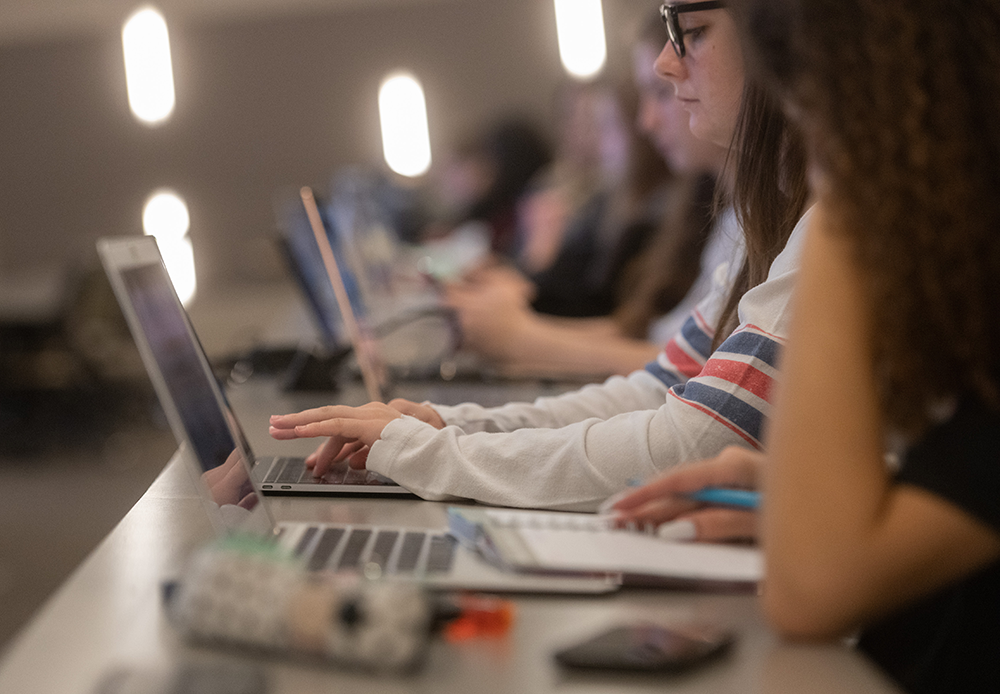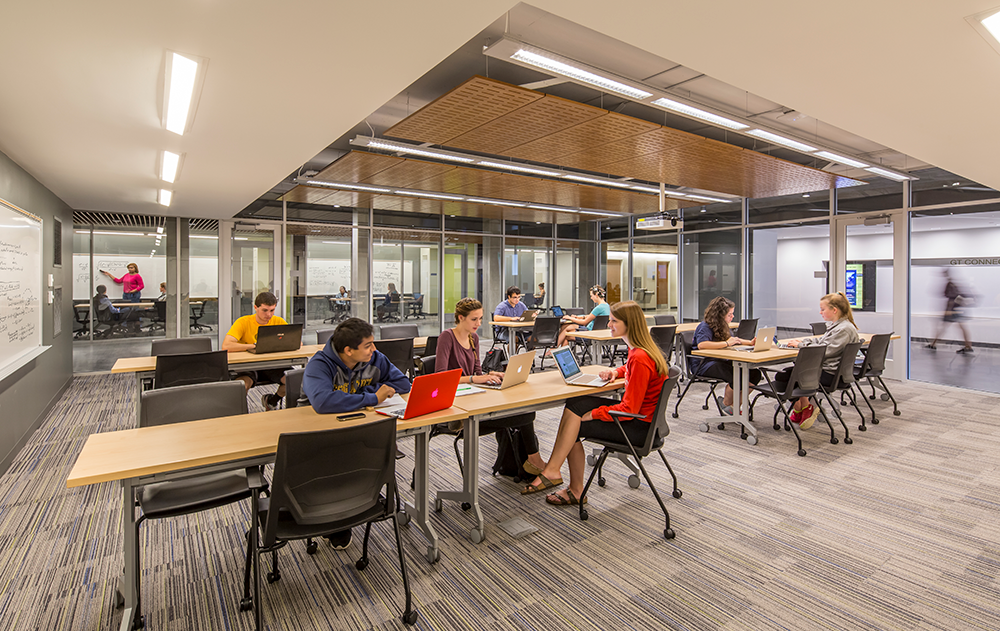C21U is a campus leader researching learning innovation who continually strives to establish partnerships and create new projects. Major research categories include technology-enabled education and learning analytics; learning spaces and distributed presence; competency-based education, microcredentials, and blockchain; and immersive virtual learning.
Technology-Enabled Education and Learning Analytics
Technology-Enabled Education
Under the broad heading of tech-enabled education, we include courses and programs integrating technology into physical classrooms and online education, including Massive Open Online Courses (MOOCs).
- Blended Learning - In combining traditional face-to-face classroom instruction with online learning, instructors can capitalize on the best of both worlds – personalization, and efficiency. Online activities run the gamut from video lectures to simulations to design-based problem-solving. While in class, instructors can have students apply what they have learned online in project-based teamwork with a design focus.

- Online Learning and Online Degree Programs – Institutions can reach broader audiences by delivering instruction, assessments, and collaboration opportunities in the online space. Many online courses are offered "asynchronously" – the learner reads, studies, and participates according to their schedule. However, there can also be synchronous components, such as Webinars and video chats, that allow students and the instructor to collaborate in real time. Students can earn certificates and degrees by completing a rigorous path of online courses that largely mirrors on-campus degree programs. Examples are Georgia Tech's Online Master of Science in Computer Science and Online Master of Science in Analytics.
- MOOCs - MOOCs have the potential to reach vastly broad audiences at low or no cost to the learner. Certificates and Nanodegree programs allow learners more personalized feedback and course credentials for less money than traditional degree programs. Students collaborate with learners from all around the world in global discussion forums or disaggregated by cohort, language, location, and even physical proximity to one another.
Analytics and Big Data
Big data is already a hot topic in business. Companies ranging from Google to Netflix to Amazon analyze patterns in how their users access information to create customized recommendations and content. In education, we have only just scratched the surface of how data can be used to personalize learning.
Through online learning programs and MOOCs, a wealth of data is generated that, when properly analyzed, can provide predictive information on student activities and success. For example, data systems that merge student information systems with admissions data with data from a school's learning management system can help to identify students at risk of failing a course or degree program. Analyses of patterns of learner behavior can help students decide whether the major they have chosen at the start of their education will be the best path for them to finish their degree. And in MOOCs, tools can be created so that students can analyze their learning patterns and ultimately self-regulate their engagement and participation.
Of course, there are privacy concerns that must be addressed not only in legal terms (for example, the Family Educational Rights and Privacy Act [FERPA] and the European Union's General Data Protection Regulation [GDPR]) but also in more general ethical terms. For example, is it right to collect and use "clickstream data," which tracks each user's path through web content, to understand more about the learner? At C21U, we watch over the privacy and security of student information while also contributing to the conversation around what is in the learner's best interest.
Learning Spaces and Distributed Presence
Physical and virtual spaces can have a significant impact on learning. Similarly, the learner's needs and expectations can drive the design of learning spaces. From multi-purpose rooms to teleconferencing to cybercafés, learning spaces can be designed with input from students, faculty, librarians, IT experts, and architects to create truly effective learning environments. Georgia Tech has implemented several learning spaces that draw from designs such as TEAL and Active Learning Classrooms.
Such learning spaces generally center on three principles:
- Bigger – More space is required when you engage in multiple activities.
- Flatter – Large, sloped-floor rooms (such as traditional lecture halls) are unsuitable for group work and collaboration.
- Faster – Multimedia and multiple display screens require robust network connectivity. There is plenty of Tech specific research to be done, including the design of the new Georgia Tech Atrium™ spaces being developed as community learning and meeting spaces in select areas in the U.S.A. and the world.

VMDO / Jonathan Hillyer Photography
Competency-Based Education, Microcredentials, and Blockchain
Competency-Based Education (CBE) is an academic option that allows learners to engage in measurable assessments and meaningful content. It is a pedagogical approach in which time is variable, and the learning is fixed. This option allows learners to build their knowledge and skills at their own pace with personalized guidance and support from engaged faculty, professionals, and support staff. In this scenario, the learner engages in learning exercises with the option to review purposeful content while earning credentials by mastering learning through multiple forms of assessments.
It is currently in high demand for several reasons: the growing need for higher education, significant changes in demographics, state and federal fiscal models, and continued technology enhancements and priorities. CBE-designed courses are often self-paced and rely on substantial investments in personnel to guide students along their paths. However, with advances in artificial intelligence and machine learning, tools such as virtual, intelligent tutoring systems are being developed at Georgia Tech to make options like CBE scalable to larger populations.
Flexible learning pathways such as CBE demand differences in measuring and counting student learning. The Carnegie Unit is still a bedrock of higher education for obtaining a degree. However, Georgia Tech views the Carnegie credit hour as not as flexible or adaptable to how learning is changing (as described above). Instead, more granular “microcredential” options that describe mastery of particular learning outcomes rather than seat time are being explored.
To that end, C21U is actively working toward becoming a national leader in blockchain technology for flexible, mastery-based learning that can be shared with other schools and employers without needing a traditional transcript generated through a registrar’s office.

Immersive Virtual Learning
Georgia Tech is building upon its established programs in virtual reality (VR) to expand its uses, augmented reality (AR), and mixed reality (MR) for purposes ranging from immersive learning to virtual advising. Key to the expansion of Georgia Tech’s course and degree programs to large audiences will be the ability to connect learners to content, faculty and advisors, and other students over vast differences. C21U’s growing role in this space is to help Tech (and others) understand the potential for such environments and make decisions applying these blossoming new tools that will drive the world’s economy in the coming decades.